基于双树复数小波变换的多帧迭代盲解卷积算法
- 格式:pdf
- 大小:1.15 MB
- 文档页数:6
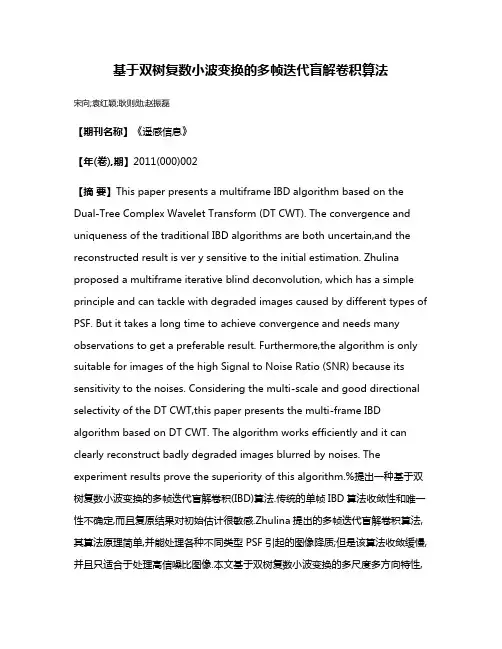
基于双树复数小波变换的多帧迭代盲解卷积算法宋向;袁红颖;耿则勋;赵振磊【期刊名称】《遥感信息》【年(卷),期】2011(000)002【摘要】This paper presents a multiframe IBD algorithm based on the Dual-Tree Complex Wavelet Transform (DT CWT). The convergence and uniqueness of the traditional IBD algorithms are both uncertain,and the reconstructed result is ver y sensitive to the initial estimation. Zhulina proposed a multiframe iterative blind deconvolution, which has a simple principle and can tackle with degraded images caused by different types of PSF. But it takes a long time to achieve convergence and needs many observations to get a preferable result. Furthermore,the algorithm is only suitable for images of the high Signal to Noise Ratio (SNR) because its sensitivity to the noises. Considering the multi-scale and good directional selectivity of the DT CWT,this paper presents the multi-frame IBD algorithm based on DT CWT. The algorithm works efficiently and it can clearly reconstruct badly degraded images blurred by noises. The experiment results prove the superiority of this algorithm.%提出一种基于双树复数小波变换的多帧迭代盲解卷积(IBD)算法.传统的单帧IBD算法收敛性和唯一性不确定,而且复原结果对初始估计很敏感.Zhulina提出的多帧迭代盲解卷积算法,其算法原理简单,并能处理各种不同类型PSF引起的图像降质;但是该算法收敛缓慢,并且只适合于处理高信噪比图像.本文基于双树复数小波变换的多尺度多方向特性,提出了一种基于双树复数小波变换的多帧IBD图像复原算法.本文算法运算速度快,且对噪声污染严重模糊图像恢复效果较好,观测数据实验结果证明了本文算法的优越性.【总页数】6页(P14-19)【作者】宋向;袁红颖;耿则勋;赵振磊【作者单位】信息工程大学测绘学院,郑州,450052;75719部队,武汉,430074;中国科技大学电子科学与技术系,合肥,230026;信息工程大学测绘学院,郑州,450052;信息工程大学测绘学院,郑州,450052【正文语种】中文【中图分类】TP751【相关文献】1.基于双密度双树复数小波变换的合成孔径雷达图像降噪研究 [J], 郭巍;张平;陈曦;朱良2.双树复数小波变换的视网膜图像半盲解卷积复原 [J], 曾明;沈建新;梁春;钮赛赛3.基于双树复数小波的快速二步迭代混合范数算法 [J], 叶润武;陈晨;刘委;孙旭;高亚红;孔尧;张鑫晟;孙海威4.基于双树复数小波变换的特征点水印算法 [J], 王兰;吴彬;韩强雷;晋克宇5.基于双树复数小波的快速二步迭代混合范数算法 [J], 叶润武[1];陈晨[2];刘委[1];孙旭[1];高亚红[1];孔尧[1];张鑫晟[1];孙海威[1]因版权原因,仅展示原文概要,查看原文内容请购买。
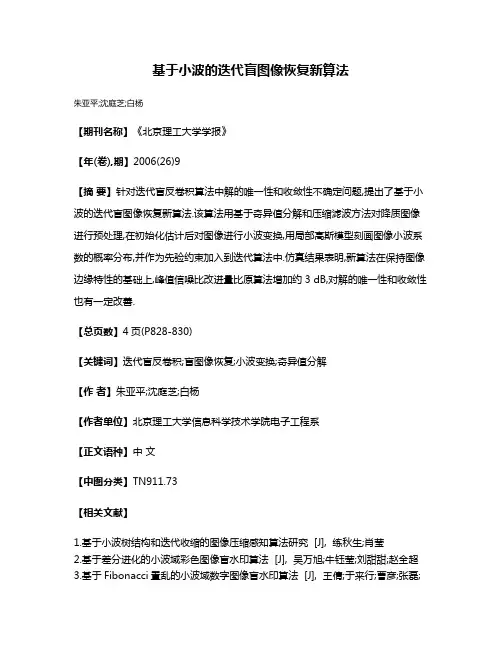
基于小波的迭代盲图像恢复新算法
朱亚平;沈庭芝;白杨
【期刊名称】《北京理工大学学报》
【年(卷),期】2006(26)9
【摘要】针对迭代盲反卷积算法中解的唯一性和收敛性不确定问题,提出了基于小波的迭代盲图像恢复新算法.该算法用基于奇异值分解和压缩滤波方法对降质图像进行预处理,在初始化估计后对图像进行小波变换,用局部高斯模型刻画图像小波系数的概率分布,并作为先验约束加入到迭代算法中.仿真结果表明,新算法在保持图像边缘特性的基础上,峰值信噪比改进量比原算法增加约3 dB,对解的唯一性和收敛性也有一定改善.
【总页数】4页(P828-830)
【关键词】迭代盲反卷积;盲图像恢复;小波变换;奇异值分解
【作者】朱亚平;沈庭芝;白杨
【作者单位】北京理工大学信息科学技术学院电子工程系
【正文语种】中文
【中图分类】TN911.73
【相关文献】
1.基于小波树结构和迭代收缩的图像压缩感知算法研究 [J], 练秋生;肖莹
2.基于差分进化的小波域彩色图像盲水印算法 [J], 吴万旭;牛钰莹;刘甜甜;赵全超
3.基于Fibonacci置乱的小波域数字图像盲水印算法 [J], 王倩;于来行;曹彦;张磊;
秦杰;叶海琴
4.基于迭代算法的小波阈值图像去噪研究 [J], 董燕;王杰;赵峰
5.基于二代小波和图像置乱的数字图像盲水印算法 [J], 杨娟;杨丹;雷明;罗建禄因版权原因,仅展示原文概要,查看原文内容请购买。
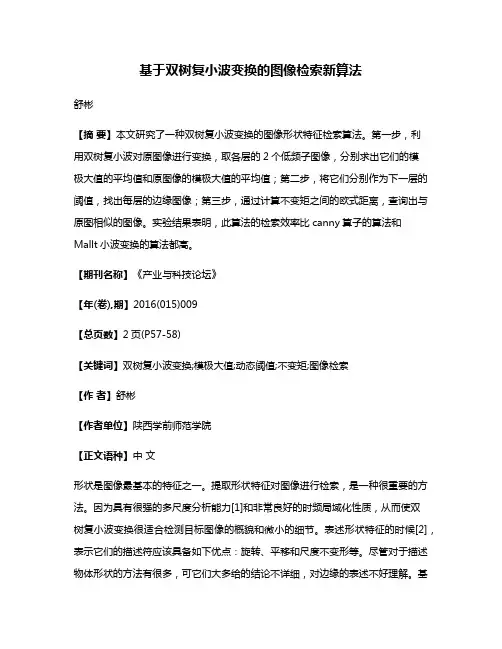
基于双树复小波变换的图像检索新算法舒彬【摘要】本文研究了一种双树复小波变换的图像形状特征检索算法。
第一步,利用双树复小波对原图像进行变换,取各层的2个低频子图像,分别求出它们的模极大值的平均值和原图像的模极大值的平均值;第二步,将它们分别作为下一层的阈值,找出每层的边缘图像;第三步,通过计算不变矩之间的欧式距离,查询出与原图相似的图像。
实验结果表明,此算法的检索效率比canny算子的算法和Mallt小波变换的算法都高。
【期刊名称】《产业与科技论坛》【年(卷),期】2016(015)009【总页数】2页(P57-58)【关键词】双树复小波变换;模极大值;动态阈值;不变矩;图像检索【作者】舒彬【作者单位】陕西学前师范学院【正文语种】中文形状是图像最基本的特征之一。
提取形状特征对图像进行检索,是一种很重要的方法。
因为具有很强的多尺度分析能力[1]和非常良好的时频局域化性质,从而使双树复小波变换很适合检测目标图像的概貌和微小的细节。
表述形状特征的时候[2],表示它们的描述符应该具备如下优点:旋转、平移和尺度不变形等。
尽管对于描述物体形状的方法有很多,可它们大多给的结论不详细,对边缘的表述不好理解。
基于此,本文研究了利用双树复小波变换对图像的形状特征进行检索的算法。
在信号分析中,如果用离散小波变换分析形状特征的话,非常微小的平移,便会引起小波系数在不同尺度上的很大差异,尽管形状相同的两个物体,产生的形状特征向量却不相同。
它缺乏方向选择性,弱化了其它方向的信息,从而丢失了一些重要的信息[3]。
为了克服这些问题,Kingsbury等人提出了双树复小波变换(Dual-tree Complex Wavelet Transform,DT-CWT)[4]。
双树复小波变换采用两个实小波可称为树A 和树B。
其中上部树A表示变换的实部,下部树B表示变换的虚部。
树A及树B 变换采用两个不同的滤波器集合,它们都符合重建条件。
假设h0(n)表示树A对应的滤波器组的低通滤波器对,h1(n)表示高通滤波器对,g0(n)表示树B对应的滤波器组的低通滤波器对,g1(n)表示高通滤波器对。
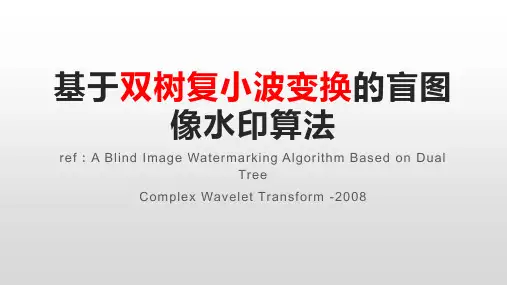
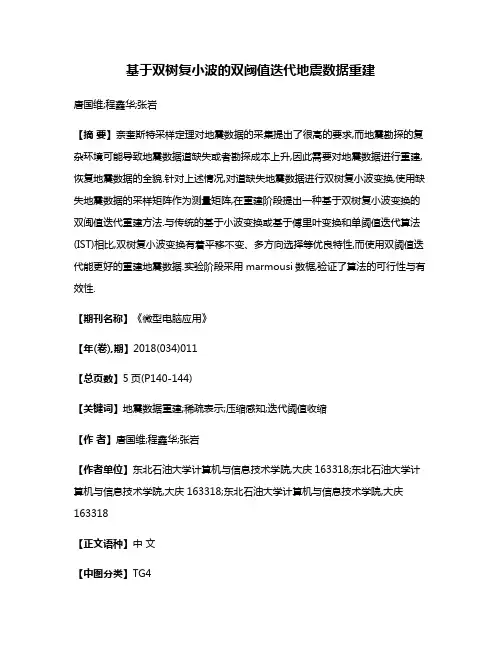
基于双树复小波的双阈值迭代地震数据重建唐国维;程鑫华;张岩【摘要】奈奎斯特采样定理对地震数据的采集提出了很高的要求,而地震勘探的复杂环境可能导致地震数据道缺失或者勘探成本上升,因此需要对地震数据进行重建,恢复地震数据的全貌.针对上述情况,对道缺失地震数据进行双树复小波变换,使用缺失地震数据的采样矩阵作为测量矩阵,在重建阶段提出一种基于双树复小波变换的双闽值迭代重建方法.与传统的基于小波变换或基于傅里叶变换和单阈值迭代算法(IST)相比,双树复小波变换有着平移不变、多方向选择等优良特性,而使用双阈值迭代能更好的重建地震数据.实验阶段采用marmousi数椐,验证了算法的可行性与有效性.【期刊名称】《微型电脑应用》【年(卷),期】2018(034)011【总页数】5页(P140-144)【关键词】地震数据重建;稀疏表示;压缩感知;迭代阈值收缩【作者】唐国维;程鑫华;张岩【作者单位】东北石油大学计算机与信息技术学院,大庆163318;东北石油大学计算机与信息技术学院,大庆163318;东北石油大学计算机与信息技术学院,大庆163318【正文语种】中文【中图分类】TG40 引言现在的高分辨率地震勘探技术对地震数据的规则性以及完整性提出了更高的要求。
然而由于客观地质条件、勘探成本以及其他环境因素,在地震勘探时,无效的地震道采样、坏道、以及各种不规则的干扰数据通常都会对地震数据进行一定程度的干扰,使得野外勘探得到的数据往往是不规则和不完整的。
若不对缺失的地震数据进行处理,会影响多次波压制、偏移等处理结果,并最终影响地震资料的解释和油气藏的评价。
在实际勘探过程中,处理不规则采样数据的一些相对简单的方法,如拷贝或线性插值出邻近道、忽略空缺道等做法均有不足之处。
因此,寻求一个快速而有效的地震数据重建方法,对于地震数据的分析以及后续工作具有重大意义。
地震数据重建,即利用一定的方法和手段对已有的道缺失地震数据进行插值重建处理,生成完整的或者采样率更高的地震数据。

A Blind Image Watermarking Algorithm Based on Dual TreeComplex Wavelet TransformS. Mabtoul , E. Ibn-Elhaj, D. AboutajdineAbstract —This paper presents a watermarking procedure for digital image in the Complex Wavelet Domain. First, a watermark image as copyright sign is preprocessed with a random location matrix. The original image is transformed in the complex wavelet domain by using DT-CWT, then, according to the characteristics of the image data, the preprocessed watermark image is adaptively spread spectrum and added into the host image DT-CWT coefficients. The superior results for image processing applications compared to the DWT [5, 6].In the proposed scheme, we applied the Dual Tree Complex Wavelet Transform; the watermark image is preprocessed with a random matrix, adaptively spread spectrum [7] and added into the host image DT-CWT coefficients.proposed watermark algorithm needs two keys: a random location matrix ensures the security of watermarking procedure and spread spectrum watermark sequence guarantees its robustness. Simulation results demonstrate the robustness of our image watermarking procedure, especially under the typical attacks of geometric operations.MI. INTRODUCTIONultimedia watermarking technology has evolved very quickly during the last few years. A digital watermark is information that is imperceptibly and robustly embedded in the host data such that it cannot be removed [1, 2].There are several watermarking algorithms transform the original image into critically sampled domain (The Discrete Real Wavelet Transform (DWT, the DiscreteCosine Transform (DCT or the Discrete Fourier Transform (DFT, and add a random sequence to the transformed image coefficients [3, 4].In general, the DWT produces watermark images with the best visual quality due to the absence of blocking artifacts. However, it has two drawbacks:--Lack of shift invariance, which means that small shifts in the input signal can cause major variations in the distribution of energy between DWT coefficients at different scales.--Poor directional selectivity for diagonal features, because the wavelet filters are separable and real.An important recent development in wavelet-related research is the design and implementation of 2-D multiscale transforms that represent edges more efficiently than does the DWT. Kingsbury’s complex dual-tree wavelet transform (DT-CWT is an outstanding example [5]. The DT-CWT is an overcomplete transform with limited redundancy (2m: 1 for m-dimensional signals. This transform has good directional selectivity and its subband responses are approximately shift-invariant. The 2-D DT-CWT has given S. Mabtoul is with the GSCM, University Mohamed V, Rabat, Morocco (e-mail: mabtoul_samira@yahoo.fr.E. Ibn-Elhaj is with the National Institute of Telecommunication (INPT, Rabat, Morocco ( phone: (+212 37 77 30 79 ; fax : (+212 37 77 30 44 e-mail:ibnelhaj@inpt.ac.ma.D. Aboutajdine is with the GSCM, University Mohamed V, Rabat, Morocco (e-mail: aboutaj@fsr.ac.ma.II. T HE P ROPOSED M ETHODA. Watermark image disorder preprocessingThe first step consists to change the watermark image W , which is a binary image {-1, 1}, into a pseudo random matrix W d by using the following equation:K: W Î Wd , Wd (K(i, j = W(i, j; i, j∈N (1Where K present the first key in our watermark procedure, which is an exclusive key to recreate the watermark image. Figure 1 visualizes an example of watermark image disorder.Original watermark image Disorder watermark imageFig. 1. The original and disorder watermark image.B. Watermark embeddingThe original image is transformed in the complex wavelet domain by using DT-CWT [5]. The watermark image is changed into a pseudo random matrix W d , then its adaptively spread spectrum W k and add into low pass subband from final level. Figure 2 shows a block diagram of the proposed watermark embedding.Fig. 3. Image detection schemeImage detection algorithm Fig. 2. Image embedding schemeImage embedding algorithm 1 DT-CWT: perform a 2-level Dual Tree Complex Wavelet on original image I orig . The DT-CWT coefficients are denoted by~. 2 Generated the spread spectrum watermark Wk : foreach pixel (i, j of the low pass image from final level in ~, the value is compared with those of its eight neighbors, t denotes the total number which the value is larger than its neighbors, as described by the following formula:≥ 4 and Wd d (i, j = 1W k (i, j = -1The spread spectrum watermark W k present the second key of our image watermarking scheme.3 Embedded watermark: the spread spectrum watermark sequence W k is embedded by the following rule:ˆI (i , j =~I (i , j +α. W ~k (i , j . I (i , j (3Where: ˆI : are the watermarked DT-CWT coefficients. ~I : are the original DT-CWT coefficients.W α: is an intensity parameter of image watermark.k : is the spread spectrum watermark image sequence. 4 IDT-CWT: by the inverse DT-CWT, we obtain the watermarked image.C. Watermark detectionWatermark detection is accomplished without referring to the original image and the original watermark image. Figure 3 shows a watermark detection scheme.1 The DT-CWT is performed on watermarked image. ˆIdenote the DT-CWT coefficients. 2 Constructed Watermark image disorderWˆd : for each embed watermark pixel inˆI, its value is compared with those of its eight n eighbors; t’ denotes the total number which the value is larger than its neighbors. Disorder watermark image can be formed as:1 if (t’ ≥ 4 and Wk (i, j = 1W ˆd (i, j’ < 4 and Wk (i, j = -13 Reconstructed watermark imageW ˆ: the reconstructed watermark i mageWˆ is obtained by using the inverse transform of the preprocessing with the first key. III. R ESULTS AND ANALYSIS Our proposed scheme has been tested under variousattacks. We chose to test this scheme under PSNR, median filter, JPEG compression, remove lines and scaling attacks introduced by Stirmark [8] and also rotation attack. We have performed the algorithm under Matlab 6.5 environment. In the experiments, we have tested tree test images ("Lena", "Barbara" and "Cameraman", and there have the similarresults. Here, we use "Lena" as an example and the watermark is a binary image with the size of 128x128 pixels.Figure 4 presents the original image, the watermarked image and the reconstructed watermark image, in which the watermark intensity factor α equal 0.004. We see that the watermarked image is not distinguishable from the originalimage. Original image Watermarked image Reconstructed watermark(256x256 pixels (256x256 pixels image (128x128pixelsFig. 4. Original and watermarked image and the reconstructedwatermark image.The robustness of watermarking is measured by thesimilarity of the detected watermark Wˆ and the originalwatermark W , which is defined as:IV. C ONCLUSIONIn this paper, we have proposed a novel scheme of imageˆ, W =ˆ(i,j.W(i,j Sim ( W (W (W(i,j (5 watermarking. This scheme applies the Dual Tree Complexi j i j Wavelet Transform; the watermark image is preprocessedwith a random matrix, adaptively spread spectrum and addedWe tested this watermark approach with DWT transform; into the DT-CWT coefficients. The experimental results the results are gathered in figure 6. have confirmed that this new scheme has high fidelity and In the first simulation, we tested the scheme’s robustness it’s robust against JPEG compression, geometr ic attacks under different PSNR situation. Figure 5.a show a typical (scaling, remove line and rotation with small angle and result. Results show that we can still correctly detect the signal processing (PSNR, median filter introduced in ∑∑∑∑2watermark under these types of PSNR attacks (figure 6.a. The results obtained with DT-CWT transform are better than the results obtained with DWT transform.We tested the robustness against median filter. Figure 5.bhas shown a typical result. The similarities of original watermark and reconstructed watermark are shown in figure 6.b. We noticed that we can still correctly detect the watermark with the algorithm used the DT-CWT transform. With the algorithm used the DWT transform, we can’t detectthe watermark if the filter factor is bigger than 7.We tested this scheme when the image undergone a scaling (see figure 5.c. The results are shown in figure 6.c. from the results obtained we notices that we can detect thewatermark image if we used the DT-CWT or the DWT. The lines dropping, which are some lines are removedfrom the watermarked image. We tested this scheme against this type of attack (see figure 5.d. The experiment result is plotted in figure 6.d. The results show that we canreconstruct the watermark image correctly if we used the DT-CWT or the DWT.We have also tested the robustness against JPEG compression (see example in figure 5.e. The corresponding results are presented in figure 6.e. this scheme is robustnessagainst this type of attack.We evaluated the robustness of this scheme against rotation attacks. Image rotation makes the coordinate axes changed. Without synchronization of orthogonal axes, we cannot reconstruct the image mark correctly Figure 5.f illustrates the effect of thistransformation. The results are shown in figure 5.f. according to the results we notices that we can reconstruct correctly the watermark image if we used the DT-CWT.StirMark. A CKNOWLEDGMENTThe authors would like to thank Dr. Nick Kingsbury forallowing use to use his DT-CWT algorithm, and for hisvaluable discussions. R EFERENCES [1] F. P. Gonzalez & Juan R. Hernandez, " A tutorial on digitalwatermarking", In IEEE Annual Carnahan Conference on SecurityTechnology, 1999. [2] Ingemar J. Cox, Matt L. Miller, " The first 50 years of electronic watermarking", Journal of Applied Signal Processing, 2, 126-132,2002.[3] A. Piva, M. Barni, F. Bartolini, and V. Cappellini, "DCT-basedwatermark recovering without restoring to the uncorrupted original image," in Inter-national Conference on Image Processing, vol. III, pp.520-523, 1997. [4] D. Kundur and D. Hatzinakos, ―A robust digital image watermarkingmethod using wavelet-based fusion,‖ in Proc. IEEE Int. Conf. Image Processing 1997 (ICIP 97, vol. 1, Santa Barbara, CA, Oct. 1997, pp. 544–547.[5] N.G. Kingsbury, ―Complex wavelets for shift invariant analysis and filtering of signals‖, Applied Computational Harmonic Anal, vol. 10,no. 3, pp. 234-253, May 2001. [6] T H Reeves and N G Kingsbury, ―Overcomplete image coding usingiterative projection-based noise shaping‖, ICIP 02, Rochester, NY, Sept 2002.[7] Z. Huai-yu, L. Ying and C. Wu: A blind spatial-temporal algorithm based on 3D wavelet for video watermarking. ICME 2004: 1727-1730.[8] F. A. P. Petitcolas, R. J. Anderson, and M. G. Kuhn, ―Attacks oncopyright marking systems,‖ in Lecture Notes in Computer Science: Information Hiding. Berlin, Germany: Springer, 1998, pp. 218–238.Watermarked image detected watermark imagewith 40 % of PSNR qualitya. Test image under PSNR attackMedian filtered Watermarked detected watermark imageimage under factor 9b. Test image under median filter attackScaled Watermarked image detected watermark image(ratio 50%c. Test image under scaling attackRemoved 100 lines of the detected watermark imagewatermarked imaged. Test image under remove lines attackJPEG compressed Watermarked image detected watermark imageof quality 35%e. Test image under JPEG compression attackRotated Watermarked Recovered image detected watermarkimage angle (10° imagef. Test image under rotation attackFig. 5. The effect of attacksPSNR (db filter factora. the effect of PSNR attackb. the effect of median filter attack factor scaling (% the number of line droppingc. the effect of scaling attackd. the effect of remove lines attackthe quality of image (%e. the effect of JPEG compression attackangle ( °f. the effect of rotation attackFig. 6. The experiment results of many attacks to the watermarking algorithm。
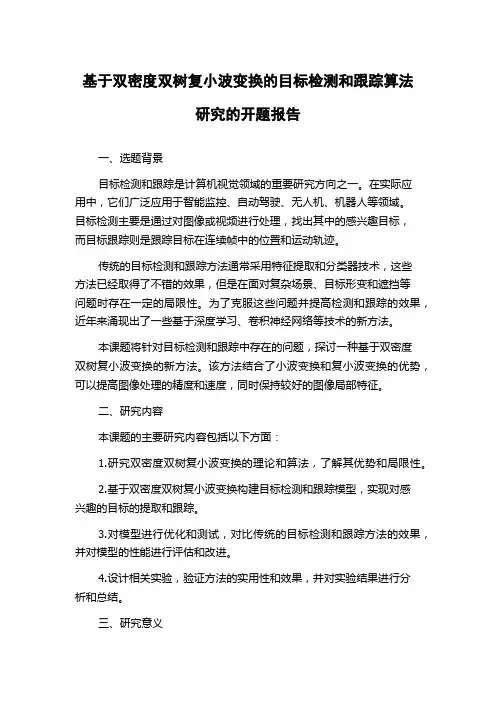
基于双密度双树复小波变换的目标检测和跟踪算法研究的开题报告一、选题背景目标检测和跟踪是计算机视觉领域的重要研究方向之一。
在实际应用中,它们广泛应用于智能监控、自动驾驶、无人机、机器人等领域。
目标检测主要是通过对图像或视频进行处理,找出其中的感兴趣目标,而目标跟踪则是跟踪目标在连续帧中的位置和运动轨迹。
传统的目标检测和跟踪方法通常采用特征提取和分类器技术,这些方法已经取得了不错的效果,但是在面对复杂场景、目标形变和遮挡等问题时存在一定的局限性。
为了克服这些问题并提高检测和跟踪的效果,近年来涌现出了一些基于深度学习、卷积神经网络等技术的新方法。
本课题将针对目标检测和跟踪中存在的问题,探讨一种基于双密度双树复小波变换的新方法。
该方法结合了小波变换和复小波变换的优势,可以提高图像处理的精度和速度,同时保持较好的图像局部特征。
二、研究内容本课题的主要研究内容包括以下方面:1.研究双密度双树复小波变换的理论和算法,了解其优势和局限性。
2.基于双密度双树复小波变换构建目标检测和跟踪模型,实现对感兴趣的目标的提取和跟踪。
3.对模型进行优化和测试,对比传统的目标检测和跟踪方法的效果,并对模型的性能进行评估和改进。
4.设计相关实验,验证方法的实用性和效果,并对实验结果进行分析和总结。
三、研究意义本课题采用基于双密度双树复小波变换的目标检测和跟踪方法,有以下研究意义:1.充分发掘小波变换和复小波变换的优势和特点,提高图像处理的精度和速度。
2.优化传统的目标检测和跟踪方法,提高检测和跟踪的成功率和鲁棒性。
3.扩展目标检测和跟踪的应用领域,使其在智能监控、自动驾驶、无人机、机器人等领域更具实用性。
四、研究方法本课题主要采用实验法和分析法进行研究,具体方法如下:1.收集本领域的相关文献和数据集,对相关技术进行深入了解和研究,为构建目标检测和跟踪模型提供理论支持。
2.设计双密度双树复小波变换的目标检测和跟踪模型,并优化模型框架和参数,提高检测和跟踪的准确性和鲁棒性。
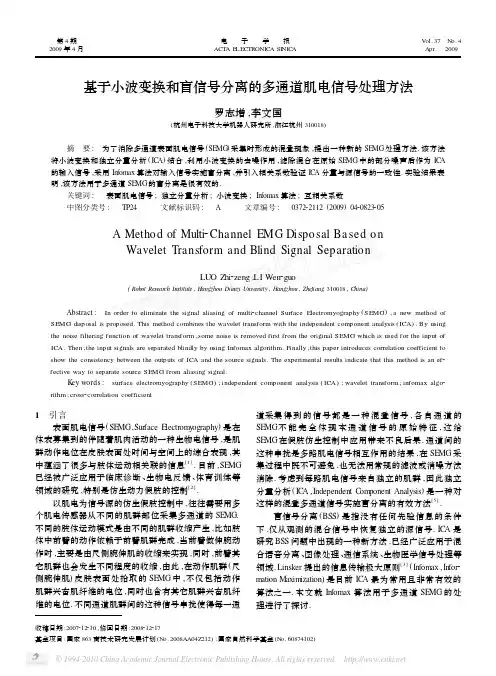
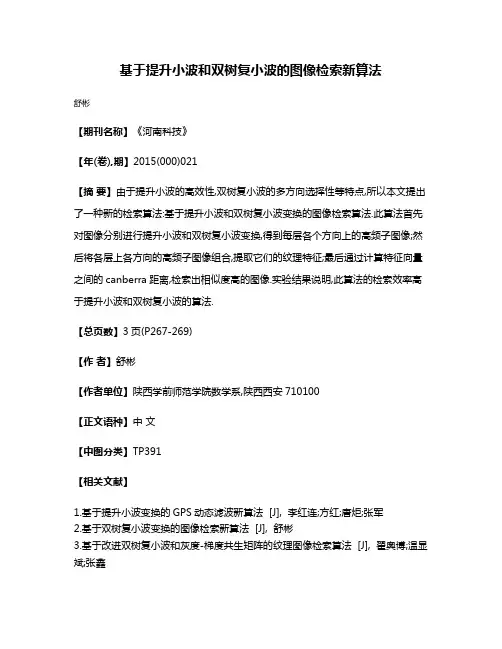
基于提升小波和双树复小波的图像检索新算法
舒彬
【期刊名称】《河南科技》
【年(卷),期】2015(000)021
【摘要】由于提升小波的高效性,双树复小波的多方向选择性等特点,所以本文提出了一种新的检索算法:基于提升小波和双树复小波变换的图像检索算法.此算法首先对图像分别进行提升小波和双树复小波变换,得到每层各个方向上的高频子图像;然后将各层上各方向的高频子图像组合,提取它们的纹理特征;最后通过计算特征向量之间的canberra距离,检索出相似度高的图像.实验结果说明,此算法的检索效率高于提升小波和双树复小波的算法.
【总页数】3页(P267-269)
【作者】舒彬
【作者单位】陕西学前师范学院数学系,陕西西安710100
【正文语种】中文
【中图分类】TP391
【相关文献】
1.基于提升小波变换的GPS动态滤波新算法 [J], 李红连;方红;唐炬;张军
2.基于双树复小波变换的图像检索新算法 [J], 舒彬
3.基于改进双树复小波和灰度-梯度共生矩阵的纹理图像检索算法 [J], 翟奥博;温显斌;张鑫
4.基于提升小波的图像检索算法 [J], 王军锋;舒彬;陈惠惠
5.一种新的基于自适应提升小波的图像检索算法 [J], 姚屹;邹北骥
因版权原因,仅展示原文概要,查看原文内容请购买。
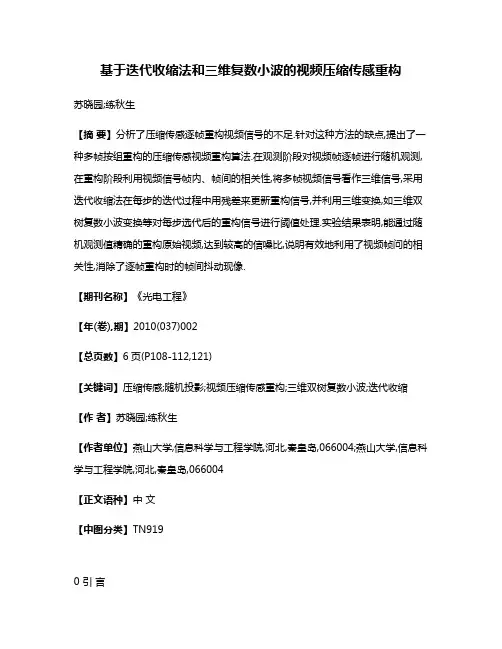
基于迭代收缩法和三维复数小波的视频压缩传感重构苏晓园;练秋生【摘要】分析了压缩传感逐帧重构视频信号的不足.针对这种方法的缺点,提出了一种多帧按组重构的压缩传感视频重构算法.在观测阶段对视频帧逐帧进行随机观测,在重构阶段利用视频信号帧内、帧间的相关性,将多帧视频信号看作三维信号,采用迭代收缩法在每步的迭代过程中用残差来更新重构信号,并利用三维变换,如三维双树复数小波变换等对每步选代后的重构信号进行阈值处理.实验结果表明,能通过随机观测值精确的重构原始视频,达到较高的信噪比,说明有效地利用了视频帧问的相关性,消除了逐帧重构时的帧间抖动现像.【期刊名称】《光电工程》【年(卷),期】2010(037)002【总页数】6页(P108-112,121)【关键词】压缩传感;随机投影;视频压缩传感重构;三维双树复数小波;迭代收缩【作者】苏晓园;练秋生【作者单位】燕山大学,信息科学与工程学院,河北,秦皇岛,066004;燕山大学,信息科学与工程学院,河北,秦皇岛,066004【正文语种】中文【中图分类】TN9190 引言由于受到Nyquist采样定理的限制,传统的视频采集系统以大于两倍信号最高频率的采样率进行采样。
首先通过传感器阵列采样原始视频数据,然后通过稀疏变换(DCT,小波变换)得到变换系数,对前K个较大的变换系数进行存储或传输。
从采集方式看,这种处理方式存在两个固有的缺点:首先,需要获取大量的原始视频数据,给存储和传输带来较大的负担;其次,压缩大量冗余视频数据需要较大的计算量。
这种压缩技术利用了信号在变换域的稀疏性的先验知识,只保留了一些较大的变换系数,丢弃了大部分系数,那么我们能不能直接获取这些重要的数据呢?近些年被人们广泛关注的压缩传感(Compressed Sensing,CS)理论解决了这个问题。
压缩传感是由David L. Donoho在稀疏表示和优化理论的基础上提出的一种数据采样理论[1-2],其本质是在对信号进行随机投影,以低于Nyquist采样率的采样得到少量观测值后,通过求解一系列优化问题,得到原始信号的逼近。
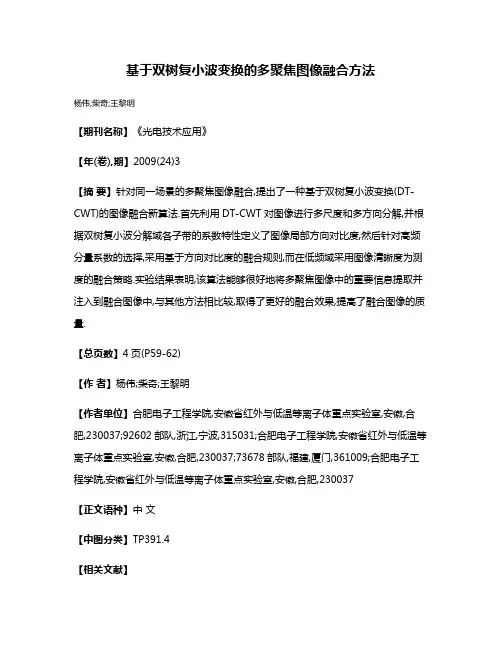
基于双树复小波变换的多聚焦图像融合方法
杨伟;柴奇;王黎明
【期刊名称】《光电技术应用》
【年(卷),期】2009(24)3
【摘要】针对同一场景的多聚焦图像融合,提出了一种基于双树复小波变换(DT-CWT)的图像融合新算法.首先利用DT-CWT对图像进行多尺度和多方向分解,并根据双树复小波分解域各子带的系数特性定义了图像局部方向对比度,然后针对高频分量系数的选择,采用基于方向对比度的融合规则,而在低频域采用图像清晰度为测度的融合策略.实验结果表明,该算法能够很好地将多聚焦图像中的重要信息提取并注入到融合图像中,与其他方法相比较,取得了更好的融合效果,提高了融合图像的质量.
【总页数】4页(P59-62)
【作者】杨伟;柴奇;王黎明
【作者单位】合肥电子工程学院,安徽省红外与低温等离子体重点实验室,安徽,合肥,230037;92602部队,浙江,宁波,315031;合肥电子工程学院,安徽省红外与低温等离子体重点实验室,安徽,合肥,230037;73678部队,福建,厦门,361009;合肥电子工程学院,安徽省红外与低温等离子体重点实验室,安徽,合肥,230037
【正文语种】中文
【中图分类】TP391.4
【相关文献】
1.基于双树复小波变换的振动信号降噪方法研究 [J], 邓娅莉;王吉芳;谷玉海;刘玉龙
2.基于双树复小波变换的多聚焦图像融合 [J], 范艳玲;杨明
3.基于双树复小波变换的多聚焦图像融合算法研究 [J], 宋瑾;石霏
4.基于双树复小波变换彩色多聚焦图像融合方法 [J], 王亚杰;李殿起;徐心和
5.基于双树复小波变换的多聚焦图像融合 [J], 宋瑾;石霏
因版权原因,仅展示原文概要,查看原文内容请购买。
基于双Sigmoid小波混沌神经网络的盲检测算法
刘欢;于舒娟;张昀
【期刊名称】《电视技术》
【年(卷),期】2015(039)005
【摘要】接要:针对在盲检测环境中暂态混沌神经网络的缺陷,提出了基于双Sigmoid小波混沌神经网络的盲检测算法,构建了新网络的模型和能量函数,并分别在同步和异步更新模式下证明了该网络的稳定性.新网络的设计思想体现在:采用墨西哥帽小波函数和Sigmoid函数的组合作为网络的激励函数,再为每个神经元加一个激活函数构成双Sigmoid.仿真表明:由于小波函数较强的逼近能力以及双Sigmoid快速收敛的特性,提出的算法显著地提高了网络的全局寻优能力和寻优精度.
【总页数】5页(P104-108)
【作者】刘欢;于舒娟;张昀
【作者单位】南京邮电大学电子科学与工程学院,江苏南京210003;南京邮电大学电子科学与工程学院,江苏南京210003;南京邮电大学电子科学与工程学院,江苏南京210003
【正文语种】中文
【中图分类】TN918.91
【相关文献】
1.基于弱信号检测理论的离散小波变换域数字水印盲检测算法 [J], 孙中伟;冯登国;武传坤
2.双Sigmoid Hopfield神经网络盲检测算法 [J], 宦如松;于舒娟;张昀
3.基于二元BKF统计建模的双树复数小波域数字水印检测算法 [J], 王向阳;李丽;李海芳;牛盼盼;王思淼;杨红颖
4.基于双树复数小波四元数卷积网络的Copy-move盲取证算法 [J], 李策;李兰;靳山岗;高伟哲;许大有
5.时变无线信道的小波盲检测算法 [J], 方承志;都思丹;倪梁方
因版权原因,仅展示原文概要,查看原文内容请购买。
基于双密度双树复小波变换多字典的人脸特征稀疏分类方法王成语;李伟红【摘要】The difficulty in sparse representation of facial images based on over-complete dictionary is the dictionary generation. This paper first introduced the Double-Density Dual-Tree Complex Wavelet Transform ( DD-DT CWT) for filtering the high-frequency sub-bands and the principle of energy distribution for selecting some sub-bands as the feature of a facial image to form multi-scale dictionaries, then viewed the similar feature of a test sample as the linear combination of some atoms in the overcomplete dictionary, finally got the recognition results via ensembling sparse representations on these dictionaries.The experimental results on AR face database demonstrate the efficiency of the proposed algorithm.%基于超完备字典的人脸稀疏表示方法的难点是其字典构成.针对此问题,首先采用双密度双树复小波变换(DD-DT CWT)提取人脸图像不同尺度的高频子带,然后根据能量平均分布最大原则选择能量较大的部分子带构成对应尺度的超完备字典.同时,将测试样本相应的人脸DD-DT CWT子带特征看成超完备字典中原子的线性组合,并组合多字典上的稀疏表示进行识别.在AR人脸图像库上进行了实验,结果表明该方法是一种有效的人脸特征表示及分类方法.【期刊名称】《计算机应用》【年(卷),期】2011(031)008【总页数】4页(P2115-2118)【关键词】超完备字典;稀疏表示;双密度双树复小波变换;特征提取;多尺度【作者】王成语;李伟红【作者单位】重庆大学,光电技术及系统教育部重点实验室,重庆400030;重庆大学,光电技术及系统教育部重点实验室,重庆400030【正文语种】中文【中图分类】TP391.4130 引言由于人脸识别在国家安全、军事安全和公共安全领域的重要地位[1-3],使人脸识别技术研究受到各国研究人员的高度重视,近年来提出的各种研究方法各具特色,最典型的有主成分分析(Principal Component Analysis,PCA)[4]2、线性鉴别分析(Linear Discriminant Analysis,LDA)[4]3以及局部保持投影(Locality Preserving Projection,LPP)[4]3、局部二元模式(Local Binary Pattern,LBP)[5]等方法。
基于双树复小波变换统计特征的图像盲取证算法
邓宇;吴云洁;周琳娜
【期刊名称】《系统仿真学报》
【年(卷),期】2011(23)8
【摘要】双树复小波变换较常用的离散小波变换具有平移不变性和方向选择性的优点。
用双树复小波变换对图像进行多尺度分解,分别计算分解后各层六个方向复高频子带系数幅值及幅值预测误差的一到五阶中心矩,并据此组合成对应的统计特征向量。
利用该统计特征向量获取方法提取真实摄影图像和计算机生成图像的统计特征向量集,并采用支持向量机进行分类。
实验结果表明,对测试集中的真实摄影图像和计算生成图像的识准率分别为98%和97%,取得了较好的分类效果。
【总页数】4页(P1660-1663)
【作者】邓宇;吴云洁;周琳娜
【作者单位】北京航空航天大学自动化科学与电气工程学院;北京航空航天大学控制一体化技术国家级重点实验室;北京电子技术应用研究所
【正文语种】中文
【中图分类】TP309.2
【相关文献】
1.基于双树复小波变换与引导滤波的红外与可见光图像融合算法
2.基于双树复小波变换的单通道盲源分离算法
3.基于双树复小波变换和频域U-Net的多光谱图像融
合算法4.基于主成分分析和双树复小波变换的CT和MRI图像融合改进算法研究5.基于双密度双树复小波变换的红外图像降噪算法
因版权原因,仅展示原文概要,查看原文内容请购买。
基于双树复数小波变换的图像清晰度判定
郭敬明;杨杰;李鸿升;黎明
【期刊名称】《上海交通大学学报》
【年(卷),期】2008(42)4
【摘要】提出了一种新的图像清晰度评价方法.该方法基于双树复数小波变换,定义高频带与低频带2-范数的比值作为图像清晰度的判定准则.实验结果表明,所提出的方法优于传统的图像清晰度准则,区分效果好,评价结果更为准确、可靠.
【总页数】5页(P579-583)
【关键词】图像清晰度;双树复数小波;细分
【作者】郭敬明;杨杰;李鸿升;黎明
【作者单位】上海交通大学图像处理与模式识别研究所
【正文语种】中文
【中图分类】TP391
【相关文献】
1.基于双密度双树复数小波变换的图像去噪 [J], 张春梅;张太镒;陆从德
2.基于双密度双树复数小波变换的合成孔径雷达图像降噪研究 [J], 郭巍;张平;陈曦;朱良
3.基于父系数及邻域系数的双树复数小波变换算法在单幅彩色图像去雾中的应用[J], 李晓飞;朱荣
4.基于双树复小波变换的图像清晰度评价算法 [J], 邹一帆
5.基于双密度双树复数小波变换的图像融合研究 [J], 岳晋;杨汝良;宦若虹
因版权原因,仅展示原文概要,查看原文内容请购买。
基于双树复小波域的马尔可夫随机场样本修补算法王爽;陈广秋;宋亚姬;孙俊喜【摘要】To eliminate the mosaic and "bell" effects due to cumulative errors during large object image inpainting, the Markov Random Fields ( MRF). Exemplar inpainting based on dual-tree complex wavelet domain was proposed. The image was converted to complex-frequency domain by Dual-Tree Complex Wavelet Transform ( DTCWT) and the exemplar inpainting order was computed by rational confidence and data item, the unknown region was inpainted based on multiscale and multiband. The inpainted images were reconstructed by dual-tree complex wavelet inverse transform. The experimental results show that compared with classical discrete wavelet methods, the mosaic and "bell" effects can be avoided and the more favorable textural and structural information can be preserved.%为了消除大目标图像修补过程中,修补区域由于累积误差引起的马赛克和振铃效应,提出基于双树复小波域的马尔可夫随机场(MRF)样本修补算法.首先应用双树复小波变换(DTCWT)将待修补图像变换到复频域,通过合理的置信度和数据项计算待修补块的修补顺序;然后应用MRF样本修补算法在不同尺度、不同方向下修补未知区域;最后利用双树复小波逆变换重构图像.实验结果表明,与传统离散小波修补方法相比,双树复小波域MRF样本修补算法能更好地保持修补区域纹理和结构信息.【期刊名称】《计算机应用》【年(卷),期】2012(032)002【总页数】4页(P493-495,503)【关键词】马尔可夫随机场;样本修补;离散小波变换;双树复小波变换;图像重构;纹理信息;结构信息【作者】王爽;陈广秋;宋亚姬;孙俊喜【作者单位】长春理工大学电子信息工程学院,长春130022;空军航空大学基础部,长春130022;长春理工大学电子信息工程学院,长春130022;空军航空大学基础部,长春130022;长春理工大学电子信息工程学院,长春130022;空军航空大学基础部,长春130022;长春理工大学电子信息工程学院,长春130022【正文语种】中文【中图分类】TP317.40 引言目前,国内外发表了许多有关马尔可夫随机场(Markov Random Field,MRF)样本修补的文献,提出了许多修补方法[1-4]。